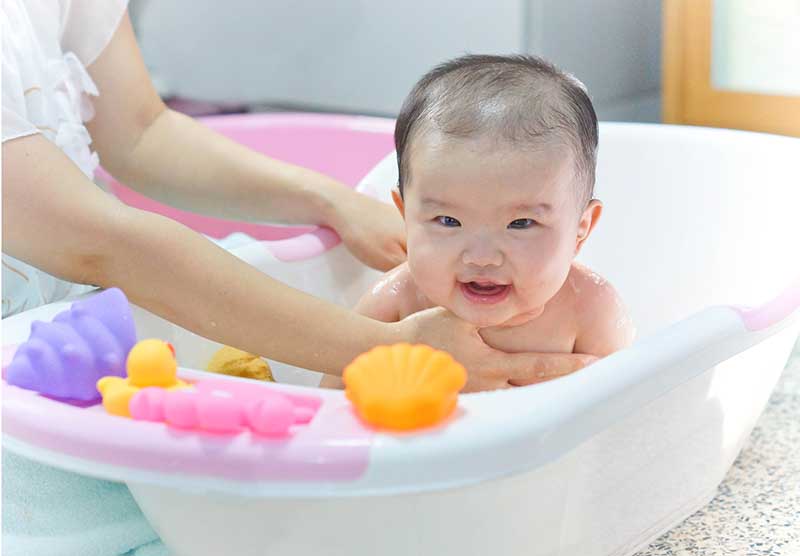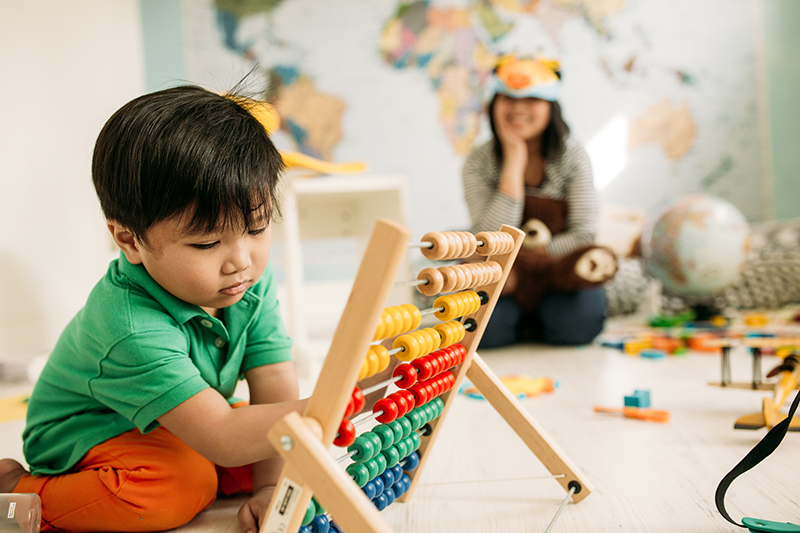Families For Life | Developing Early Numeracy Skills-Young Children

DID YOU KNOW?
Bath time is a good way to soothe your baby but it can also be a fantastic learning opportunity for your child. Learn how you can engage him during bath time.
READ MORE

Children begin to develop numeracy skills from a very early age. You can introduce maths skills and ideas into everyday activities with your child to help build early numeracy.
About numeracy and maths skills
Numeracy is the ability to apply maths concepts in all areas of life.
Numeracy skills involve understanding numbers, counting, solving number problems, measuring, sorting, noticing patterns, adding and subtracting numbers and so on.
We all need numeracy and maths skills to do everyday things like:
solve problems – for example, which brand and size of tinned beans is the cheapest?
analyse and make sense of information – for example, how many wins does my team need to get to the top of the competition?
understand patterns – for example, what number would the next house in this street be?
make choices – for example, which bicycle is the best value?
Your child’s everyday experiences are full of learning opportunities that lay the foundations for numeracy.
How your child starts learning numeracy
Children start learning numeracy skills from the time they’re born. This learning happens through everyday play and activities – for example, when you encourage your child to:
count fingers, toes and toys
recognise numbers on objects like clocks or remote controls
decide how many slices of apple she wants.
As your child gets older, he learns more numeracy and maths skills, including size and measurement – for example, when he starts to:
help set the table
fill a water bottle
divide food into equal shares
compare things of different sizes – ‘big’, ‘small’ and ‘medium’
use words to describe where things are – ‘over’, ‘under’ and ‘next to’
help with the shopping and use money to buy things.
And when you talk with your child about maths concepts in your everyday activities, it helps her understand how and why maths is useful. For example, this happens when you point out:
big and small (size)
high and low (height)
heavy and light (weight)
fast and slow (speed)
close and far (distance)
first, second and last (order)
Babies: tips for building numeracy skills
Your baby loves hearing your voice and enjoys stories and songs with repetition, rhyme and numbers. Some things you might already be doing, or could start doing, with your baby to build numeracy skills include:
reading stories with numbers
counting
singing number songs and rhymes
changing your tone of voice to describe concepts – for example, a big voice to describe something big, or a little voice to describe something little.
You can also talk about:
everyday activities – for example, ‘I’m going to fill up your bath’
the environment – for example, ‘Look at the little bird over there’ or ‘That’s a big dog’
food – for example, ‘Let’s have two pieces of banana’ or ‘How many apple slices do you want?’
time – for example, ‘7 pm, time for bed’
It’s best if you can make these everyday numeracy activities and experiences playful and relaxed so that they’re fun for your child.
Toddlers: tips for building numeracy skills
Playing with your toddler helps your child develop communication, imagination and other skills that prepare him for learning maths. Here are some ideas to help you and your child enjoy play together – and learn early maths skills along the way!
Ideas for talking
Use mathematical concepts to describe what you and your child are seeing and doing together – for example, ‘Look at the big red ball’ or ‘What a little kitten’.
Point out and name the numbers in your phone number and address.
Read speed limits on road signs.
Read the numbers on the car dashboard.
When you’re preparing food, talk about what you’re doing. For example, ‘I’m cutting this orange in half’ or ‘Let’s share these sultanas – one for me and one for you’.
Talk about activities that happen at certain times of the day – ‘We eat breakfast at 7 am’, or ‘7 pm – it’s past your bedtime’.
Ideas for everyday activities
Make counting part of your everyday life. For example, count toys, shells at the beach, fruit at the grocery store or trees on the street.
When you’re out and about, encourage your child to compare sizes of stones, bushes and trees, and describe shapes of leaves, colours of flowers or sizes of birds.
Go for a walk down your street and point out how each house or block has a number in a series. Count the steps between one house and the next.
Use a growth chart or marks on a wall to measure your child’s growing height, and describe to your child what you’re doing.
Involve your child in cooking. Your child can help stir, pour, fill and mix. This will help your child learn to count, measure, add and estimate.
Ideas for play
Use shape sorters or cut out different shapes from paper. Talk with your child about each shape by counting the sides, describing colours and looking for other objects that are the same shape.
Help your child arrange her favourite toys in order from shortest to tallest.
Gather a mix of small toys, pegs or pebbles together with your child. Sort them into groups based on size, colour, shape or what they do. Just make sure none of the pieces go into your child’s mouth, and put them away when you’re finished.
Sing the alphabet song while clapping or jumping its rhythm. Sing songs and read books that have numbers in them that repeat, rhyme and have rhythm. This will help your child understand patterns.
Try simple board games, card games and puzzles with shapes and numbers, like ‘snap’, or matching pairs or dominoes.
Play outside games like ‘I spy’, hopscotch, skittles and ‘What’s the time Mr Wolf’.
Ideas for books and reading
Here are some books that feature numbers and counting:
The Very Hungry Caterpillar by Eric Carle
One Fish, Two Fish, Red Fish, Blue Fish by Dr Seuss
Ten Little Ladybugs by Melanie Gerth
Counting Kisses by Karen Katz
Ten Little Fingers And Ten Little Toes by Mem Fox
One Woolly Wombat by Kerry Argent
Ten Little Dinosaurs by Mike Brownlow
Children learn best when they’re interested in something. If your child is doing something he’s particularly interested in – whether it involves dinosaurs, dolls, cars, building, insects or whatever – you can use and explore maths concepts with him while he plays.
Video: Math In Daily Activities
Introduce the world of numbers to your little one through day-to-day activities! Here, we share how simple activities can help your little one make sense of everyday situations and develop numeracy at the same time.
© raisingchildren.net.au, translated and adapted with permission
Explore more